Croton, Garden Croton
Croton or Codiaeum variegatum stands out for its dramatic foliage, making it a popular choice for gardeners and homeowners looking to add a splash of color to their environment. With proper care, Crotons can be a stunning addition to any tropical-themed garden or interior space.
Codiaeum variegatum, or Croton, is a foliage plant celebrated for its vibrant, variegated leaves that come in a kaleidoscope of colors, including yellow, red, orange, and deep green, often on the same leaf.
Native: Native to the tropical forests of Southeast Asia and the Pacific Islands, Croton thrives in warm, humid environments. It belongs to the spurge family (Euphorbiaceae), along with poinsettia and the castor oil plant.
Plant Type and Habit: This tropical, evergreen shrub or small tree is known for its upright growth habit and can be pruned into various shapes, making it a versatile addition to gardens and indoor spaces.
Size: Crotons can grow up to 3-10 feet tall (90-300 cm) and 3-6 feet wide (90-180 cm), depending on the variety and growing conditions.
Flowers: Crotons produce small, inconspicuous flowers in spring that are not the main attraction compared to their stunning foliage. Male flowers, white with five petals and 20-30 stamens, create a starburst effect, contrasting with the yellowish, petal-less female flowers on separate inflorescences. When grown as a houseplant, it rarely flowers. The pollinated female flowers are followed by small fruits containing three seeds.
Foliage: Croton’s foliage is a vibrant spectacle, featuring leaves 2 to 12 inches long (5 to 30 cm) in a dazzling array of colors from yellow, red, and orange to deep greens and purples, often splashed or veined together on a single leaf. Each variety boasts unique patterns and shapes, ranging from broad, glossy leaves to narrow, twisted ones, making Crotons a striking choice for adding a bold splash of tropical flair to indoor and outdoor spaces.
Hardiness: They are hardy in USDA zones 11-12 and require protection from cold in cooler climates. They thrive outdoors in areas where winter temperatures stay above 10 to 13°C (50 to 55°F), ensuring their survival and continued splendor.
Uses: Crotons are primarily used for ornamental purposes, brightening up indoor and outdoor spaces with their colorful leaves. In tropical climates, crotons serve as stunning hedges and potted patio highlights, prized for their vibrant foliage. In cooler climates, it makes a terrific houseplant.
Toxicity: The bark, roots, latex, leaves, and seeds of Crotons are toxic when ingested, causing irritation to the mouth, stomach, and potentially more severe symptoms in pets and humans. The sap can cause dermatitis in some people.
Deer and Rabbits: Their toxicity and bitter taste tend to deter deer and rabbits.
Drought: Crotons prefer consistent moisture and are not particularly drought-tolerant, requiring regular watering to keep their leaves vibrant.
Invasiveness: This plant is not reported as invasive.
Benefits: Crotons stand out for their vibrant, colorful foliage, contributing not just to visual appeal but also to air purification by removing pollutants, enhancing indoor air quality and promoting a healthier living environment.
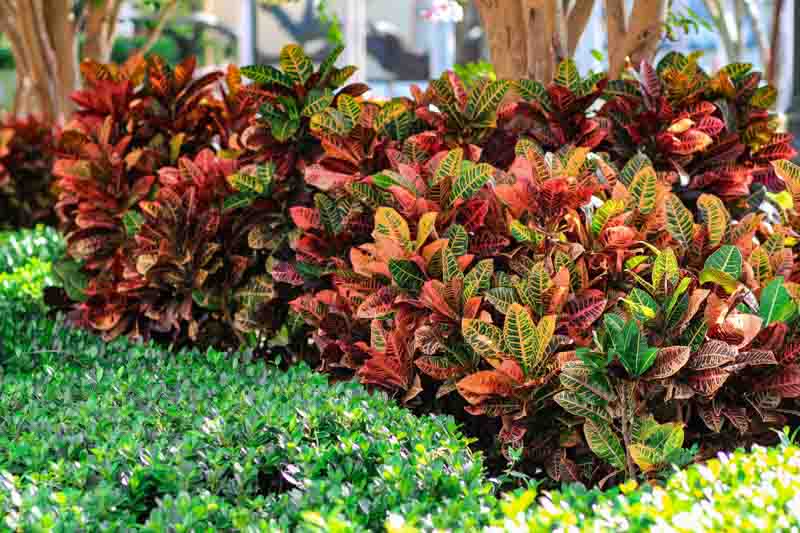
Growing and caring for Croton indoors successfully involves providing optimal conditions that mimic its natural tropical habitat.
Light: Crotons need bright, indirect sunlight to thrive and maintain their vibrant colors. A spot near an east or south-facing window is ideal. Rotate the plant regularly for even growth.
Soil: Use a well-draining, peat-based potting mix with a slightly acidic to neutral pH. Good drainage is key to preventing root rot.
Water: Water when the top inch of soil becomes dry, ensuring the soil is evenly moist but not soggy. Overwatering can lead to root rot, while under-watering may cause leaf drop. Reduce watering in the winter.
Temperature and Humidity: Keep the temperature between 60°F and 85°F (16°C to 29°C). Avoid placing your Croton near cold drafts or heating vents, as drastic temperature changes can stress the plant. As a tropical plant, it prefers high humidity. Mist the leaves regularly, use a pebble tray, or place a humidifier nearby to increase moisture in the air.
Fertilization: Feed your Croton with a balanced, water-soluble fertilizer every 4-6 weeks during the growing season. Reduce feeding in the winter.
Pruning: Prune in spring to maintain shape and encourage bushier growth. You can also pinch back the tips to promote more branches.
Repotting: Repot every 1-2 years or when the plant becomes root-bound. Choose a pot that’s slightly larger than the current one to encourage growth.
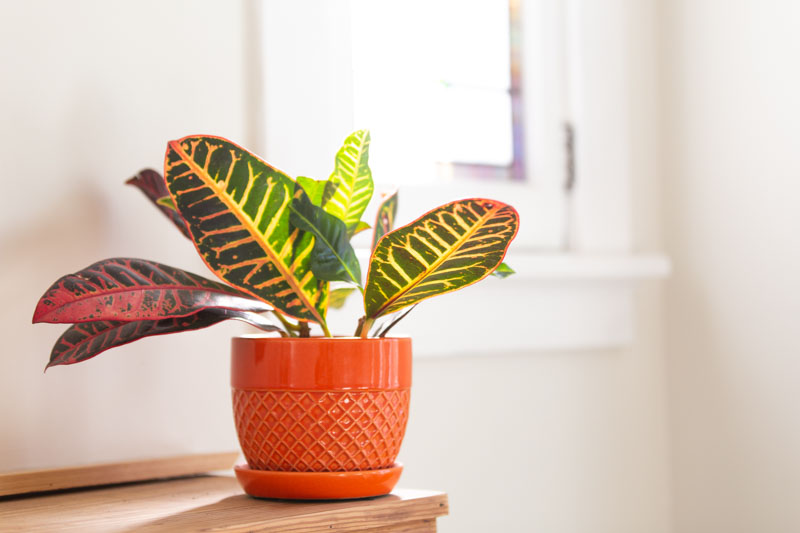
Growing and caring for Croton outdoors requires understanding its tropical nature and providing an environment that caters to its needs.
Light: Crotons thrive in partial shade but can endure full sun in cool climates if kept moist. Bright light enhances leaf color vibrancy and a more compact plant. Insufficient light turns leaves green, whereas excessive direct sunlight causes leaves to become gray and dull, diminishing their beauty. Choose a location sheltered from strong winds, which can damage the leaves.
Soil: Crotons prefer well-draining, fertile soil. They have a tolerance for acidic, alkaline, sand, loam, and clay soils. Amend the planting area with organic compost to enhance soil structure and fertility.
Planting: Plant Crotons in the spring or early summer when the threat of frost has passed. Ensure the hole is twice as wide and just as deep as the root ball. Space plants, according to their mature size to prevent overcrowding.
Water: Water when the top inch of soil becomes dry, ensuring the soil is evenly moist but not soggy. Overwatering can lead to root rot, while under-watering may cause leaf drop. Reduce watering in the winter.
Fertilization: Feed Crotons with a balanced, slow-release fertilizer in early spring and again in mid-summer to support vigorous growth and vibrant foliage color.
Pruning: Prune in late winter or early spring to maintain shape and encourage bushier growth. Remove any damaged or diseased foliage as needed.
Mulching: Apply a layer of organic mulch around the base of the plant to retain soil moisture, regulate soil temperature, and reduce weed competition.
Cold Protection: In regions where temperatures drop below 50°F (10°C), consider growing Crotons in containers that can be moved indoors or provide adequate frost protection outdoors.
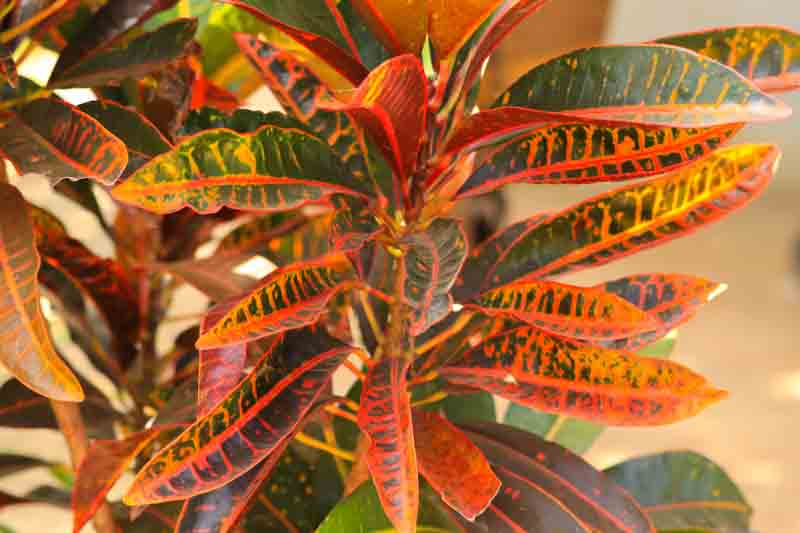
Propagating Croton can be a rewarding way to create new plants from your existing Croton. The most common and effective method of propagation for Crotons is through stem cuttings. Here’s a step-by-step guide:
Select a Healthy Stem: Choose a healthy, mature stem from the Croton plant. Look for a stem that’s free of pests, diseases, and has vibrant foliage.
Cut the Stem: Using a clean, sharp pair of pruning shears or a knife, cut a 4-6 inch section (10-15 cm) of the stem. Make sure the cutting has at least 3-5 leaves on it. Cut just below a leaf node (the point where a leaf grows out of the stem).
Prepare the Cutting: Remove the leaves from the lower half of the cutting to prevent them from rotting when planted. This also reduces moisture loss, allowing the cutting to focus its energy on root development.
Rooting Hormone (Optional): Dip the cut end of the stem into rooting hormone powder or gel. This step is optional but can help stimulate root growth and increase the success rate of propagation.
Plant the Cutting: Fill a small pot with a well-draining potting mix, such as a mix designed for tropical plants or a mixture of peat and perlite. Make a hole in the center of the soil and insert the cut end of the stem. Gently firm the soil around the stem to hold it in place.
Water and Cover: Water the soil lightly to settle it around the cutting. To maintain humidity, cover the pot with a plastic bag or place it in a mini greenhouse. Ensure the plastic does not touch the leaves by supporting it with sticks or wires.
Place in Indirect Light: Position the pot in a warm location with bright, indirect light. Avoid direct sunlight, which can overheat and dehydrate the cutting.
Monitor and Wait: Keep the soil consistently moist but not waterlogged. In about 4-8 weeks, the cutting should develop roots. You can gently tug on the cutting to feel for resistance, indicating root growth.
Transplanting: Once the cutting has established a robust root system, you can transplant it into a larger pot or directly into the garden (in suitable climates).
Remember, patience is key when propagating Crotons, as it can take several weeks for new roots to form. With proper care, your new Croton plants will soon thrive and bring vibrant color to your garden or home.
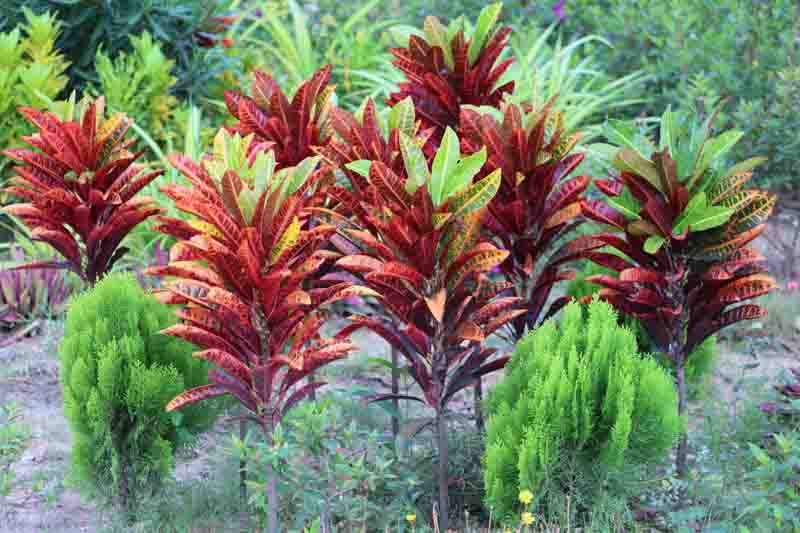
Crotons are vibrant tropical plants that can sometimes encounter pests, diseases, and common problems.
Spider Mites: These tiny pests thrive in dry conditions, sucking sap from leaves, leading to yellowing and webbing. Increase humidity and wash plants with water; use miticides if necessary.
Mealybugs: Look for white, cottony masses on stems and undersides of leaves. Remove with alcohol-dipped cotton swabs or apply insecticidal soap.
Scale insects: Hard, shell-like pests that adhere to stems and leaves, sucking sap. Treat with horticultural oil or neem oil.
Root rot: Overwatering can lead to fungal diseases in the roots, causing wilting and yellowing leaves. Ensure proper drainage and let the soil dry slightly between waterings.
Leaf spot: Fungal or bacterial infections causing spots on leaves. Improve air circulation, avoid wetting foliage, and treat with fungicides.
Crown Gall: A bacterial infection causing swollen growths on croton’s roots and stems. These galls hinder nutrient and water flow, stunting plant growth. Management includes removing affected areas and sterilizing tools.
Anthracnose: A fungal disease marked by dark, water-soaked spots on croton leaves, leading to defoliation and weakened plants. Control involves removing infected foliage and improving air circulation.
Leaf Drop: Sudden changes in light, temperature, or watering can stress Crotons, causing them to drop leaves. Keep conditions consistent and gradually acclimate plants to new environments.
Fading Color: Insufficient light can cause Croton’s leaves to lose their vibrant hues. Place in bright, indirect light to maintain color intensity.
Legginess: Lack of light may lead to sparse, leggy growth. Prune back leggy stems to encourage bushier growth and ensure adequate light.
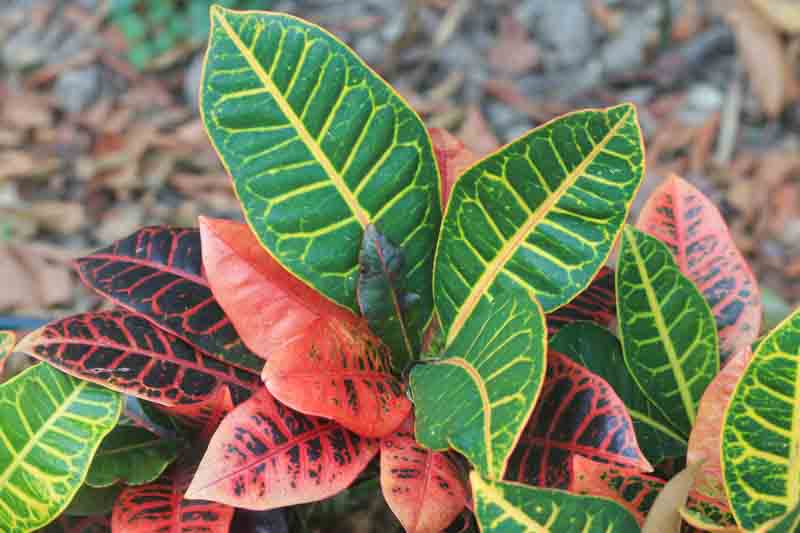
Crotons prefer bright, indirect sunlight. They thrive in environments where they can receive plenty of light without being exposed to the harsh afternoon sun. Some varieties can tolerate more direct sunlight than others, but generally, a little shade during the hottest part of the day helps maintain their vibrant colors.
Crotons can be both indoor and outdoor plants, depending on the climate. In tropical or subtropical climates, they do well outdoors year-round. In cooler climates, they are popular as indoor or outdoor plants during the warmer months, then moved inside when temperatures drop.
Crotons can be challenging to grow for some due to their need for high humidity, warm temperatures, and bright light, which might not be readily available in all homes or gardens.
If a Croton loses all its leaves, it’s not necessarily dead. This can be a reaction to stress, such as sudden temperature changes, improper watering, or relocation. Before concluding that the plant is dead, check the stem and roots for signs of life. If the stems are still firm and the roots healthy, there’s a chance for recovery with proper care and adjustments to its environment.
A Croton plant can live for many years, often several decades, with proper care. Its longevity is influenced by factors such as adequate light, humidity, and temperature conditions. Indoors, with consistent care meeting its tropical needs, a Croton can thrive indefinitely, becoming a long-lasting, vibrant addition to any space.
| Hardiness |
11 - 12 |
|---|---|
| Plant Type | Houseplants, Shrubs, Trees |
| Plant Family | Euphorbiaceae |
| Exposure | Full Sun, Partial Sun |
| Season of Interest |
Spring (Early, Mid, Late) Summer (Early, Mid, Late) Fall Winter |
| Height |
3' - 10' (90cm - 3m) |
| Spread |
3' - 6' (90cm - 180cm) |
| Spacing |
36" - 72" (90cm - 180cm) |
| Maintenance | Low |
| Water Needs | Average |
| Soil Type | Loam, Clay, Sand |
| Soil pH | Acid, Neutral, Alkaline |
| Soil Drainage | Moist but Well-Drained |
| Characteristics | Showy, Evergreen |
| Garden Uses | Beds And Borders, Hedges And Screens, Patio And Containers |
| Garden Styles | Mediterranean Garden |
| Hardiness |
11 - 12 |
|---|---|
| Plant Type | Houseplants, Shrubs, Trees |
| Plant Family | Euphorbiaceae |
| Exposure | Full Sun, Partial Sun |
| Season of Interest |
Spring (Early, Mid, Late) Summer (Early, Mid, Late) Fall Winter |
| Height |
3' - 10' (90cm - 3m) |
| Spread |
3' - 6' (90cm - 180cm) |
| Spacing |
36" - 72" (90cm - 180cm) |
| Maintenance | Low |
| Water Needs | Average |
| Soil Type | Loam, Clay, Sand |
| Soil pH | Acid, Neutral, Alkaline |
| Soil Drainage | Moist but Well-Drained |
| Characteristics | Showy, Evergreen |
| Garden Uses | Beds And Borders, Hedges And Screens, Patio And Containers |
| Garden Styles | Mediterranean Garden |
How many Codiaeum variegatum (Croton) do I need for my garden?
| Plant | Quantity | |
|---|---|---|
| Codiaeum variegatum (Croton) | N/A | Buy Plants |
Create a membership account to save your garden designs and to view them on any device.
Becoming a contributing member of Gardenia is easy and can be done in just a few minutes. If you provide us with your name, email address and the payment of a modest $25 annual membership fee, you will become a full member, enabling you to design and save up to 25 of your garden design ideas.
Join now and start creating your dream garden!
Create a membership account to save your garden designs and to view them on any device.
Becoming a contributing member of Gardenia is easy and can be done in just a few minutes. If you provide us with your name, email address and the payment of a modest $25 annual membership fee, you will become a full member, enabling you to design and save up to 25 of your garden design ideas.
Join now and start creating your dream garden!